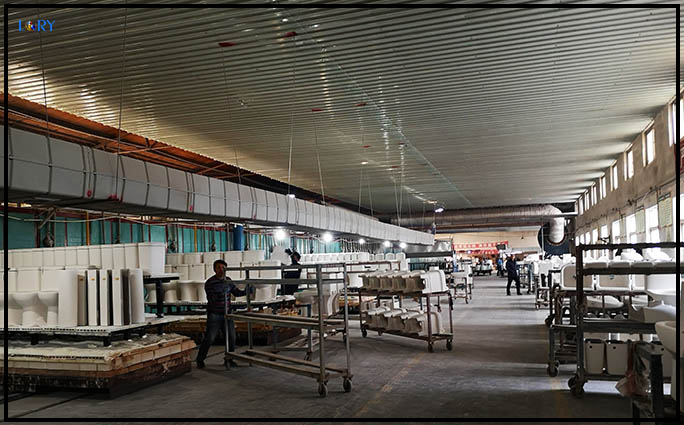Abstract: This article introduces the key points and technical difficulties of using tunnel kilns for the refiring of sanitary ceramics, achieving simultaneous firing of sanitary ceramics in both primary and secondary firing.
Keywords:Sanitary ceramics, tunnel kiln, re fired
After one firing of our LORY company’s sanitary ceramics, about 8% of the products cannot be graded due to defects such as brown eyes, dirt, melting holes, and shrinkage glaze. If relevant defects are not remedied in the later stage, such products cannot be accepted by the market and can only be classified as scrap.

There are three types of post repair measures at home and abroad sanitary ware manufacturers :
(1) laser curing repair using dental repair materials;
(2) spraying resin materials to form a thin layer of glaze;
(3) using shuttle kilns for secondary firing of products, known as re firing technology.
The first two methods are only suitable for repairing low-end products due to the significant difference between the materials used and ceramic materials, resulting in obvious repair marks and easy peeling.Widely adopted in the sanitary ceramics industry is the third method, which uses a shuttle kiln for secondary firing of products, also known as re firing. The re firing technology of sanitary ceramics refers to the process of repairing small defects that affect the appearance and glaze quality of sanitary ceramics, such as pinholes, brown eyes, spots, local lack of glaze, glaze strands, small cracks, etc., and then re firing them into high-quality or qualified products through surface treatment such as blank filling, glaze filling, and re spraying.
1. Reburning process
Shuttle kilns are commonly used as heavy firing furnaces in the sanitary ceramics industry. As an intermittent kiln, shuttle kiln has flexible adjustment of heating rate, firing temperature, and temperature curve, which sanitary ware manufacturers can be adjusted at any time according to the product situation. According to reports, the maximum firing temperature for secondary firing should be 40-50 ℃ lower than the primary firing temperature. The heating rate should be reduced, the firing cycle should be extended, and structural stress should be avoided to cause product cracking.
2. Repair
Brown eyes, melt holes, and shrinkage glazes require polishing the defective areas with a grinding gun to form a rough surface and prevent defects from becoming pits. Fill the pit with an appropriate amount of base glaze, with the surface slightly higher than the glaze to form an arch. After the base glaze dries, spray the surface glaze locally to form a transition layer between the repaired area and the surrounding area, reducing the color difference between the repaired point and other parts.
For small stains, an air grinder can be used to polish the surface to form a rough surface. Directly spray the surface glaze, and during the grinding process, try to be as stable and accurate as possible to minimize the range of repair areas.
3. Causes and Countermeasures of Bubbling
After secondary firing, some products showed bubbling defects. The so-called bulging is defined as the internal expansion of the billet body, which bulges around, forming an irregular spherical protrusion with a smooth surface, a hollow center, or a honeycomb like shape. After research, we believe that the most fundamental cause of bubble formation is due to the inability to timely discharge, mutual accumulation, and expansion of the gas generated during the firing process of the billet. Therefore, the most fundamental way to solve this defect is to reduce the generation of gas during the firing process of the billet, especially after a large amount of liquid phase appears in the billet; The second is to enable the generated gas to quickly escape. Solve such defects through reasonable adjustment of the mud material.
4. Deformation
In ceramic production, deformation has always been considered a regrettable experience and the most difficult process key to handle. The main reasons are uneven thickness of the body, uneven edge support pulling on the entire plane, uneven kiln loading, uneven fire exposure, and other factors.
The key to solving the problem of deformation and maintaining the flatness of the ceramic tabletop and feet is the role of the cushion head before entering the kiln. If encountering semi-finished products with uneven defects during the drying process, the only remedial measure is to pay attention to the installation method during kiln installation, fully estimate the high points of the uneven tabletop, and accurately identify the high and low points after installation, and place them below temporarily unable to contact the nail feet of the tabletop, wait for the high-temperature sintering in the kiln to soften and fall into contact with the pre discharged nail feet, gradually restoring the tabletop to a flat surface during the firing process.
Conclusion
The significance of refiring repair technology lies in its ability to extend the lifespan of ceramic sanitary products, reducing waste, and conserving resources. By allowing manufacturers to salvage defective pieces through a cost-effective and sustainable repair process, it mitigates the need for discarding and remanufacturing, thereby minimizing the overall environmental impact. This approach aligns with the principles of circular economy, promoting resource efficiency and waste reduction throughout the product lifecycle.
In conclusion, refiring repair technology for ceramic sanitary products emerges as a revolutionary and indispensable solution for addressing the challenges of product defects and environmental concerns in the ceramics industry. The research and advancements in this technology have showcased remarkable potential, offering manufacturers, consumers, and the environment a host of benefits that cannot be ignored.